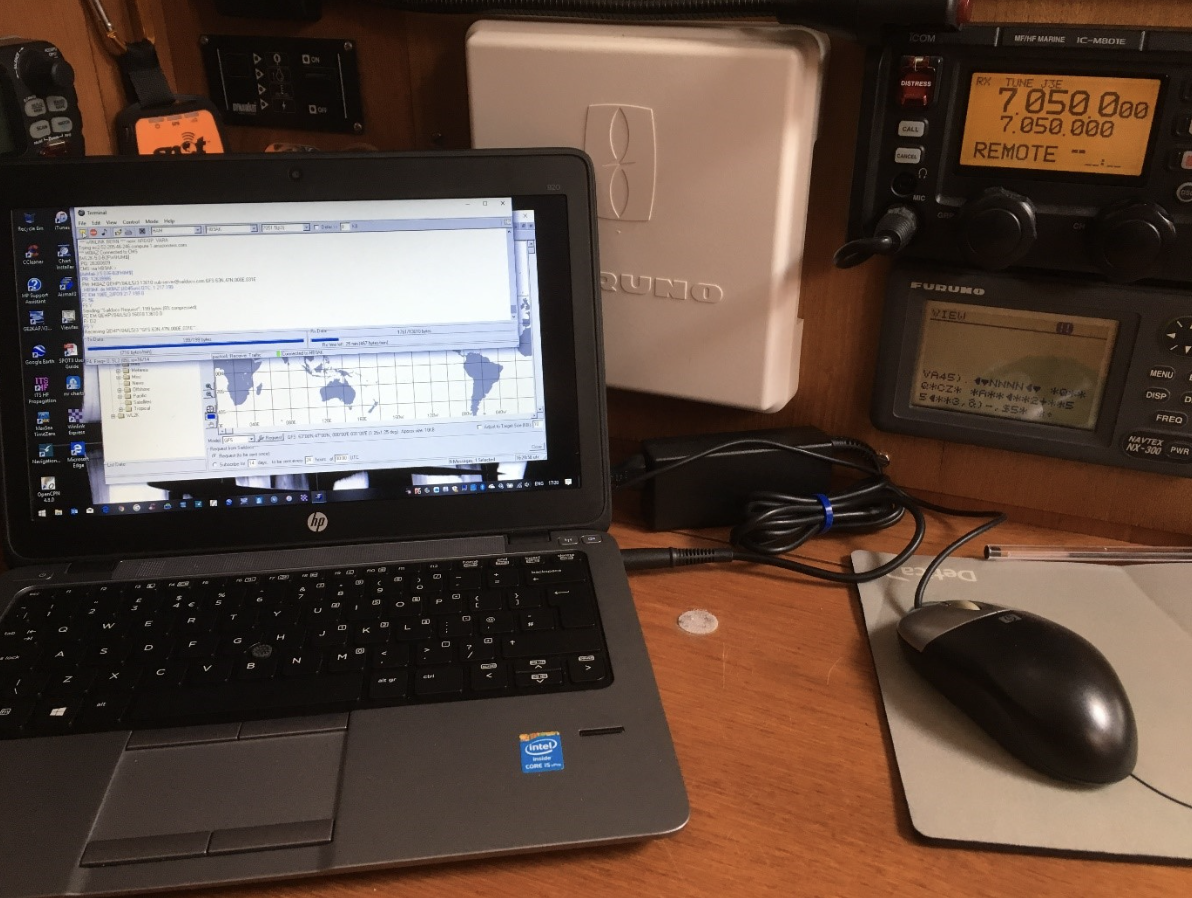
Nearly 30 years ago, a younger Bill Gates suggested that “we’ll have infinite bandwidth in a decade’s time”. 25 years after that when I moved to my present home, I had to go and buy a pay-as-you-go sim card for my mobile phone, as it would take a month to install a landline and broadband in rural Devon, and my then 4G provider had no mast of its own in range of me. A month later we were once more lapping up our ‘full-fat’ fibre and streaming high-definition Netflix videos to multiple TVs.
The following summer I made my annual escape for some offshore sailing. Afloat, the inner nerd still in me could enjoy the maritime or ham radio challenge of downloading (at less than 1kB/min!) the synoptic weather charts and forecasts via HF radio and Pactor modem from distant transmitters in Hamburg or Bern. Generally, though, I have to admit the Baltic sea nations all have some of the world’s best 4G+ networks – at least until you are more than 3 miles offshore.

This is a view of my floating radio ‘rig’ in the photograph. The eagle-eyed may also spot (excuse the pun) an orange ‘SPOT’ satellite GPS tracker and emergency alarm device. This is capable only of transmitting tracks and one of three possible pre-prepared messages, no longer than the original ‘tweets and it receives nothing in return. That makes you think hard about exactly what you would want to be able to tell the world should your floating ‘pride and joy’ ever start sinking beneath stormy waves.
While still indulging this tour of my navigation table, there is one other precious and masterful example of efficiency in low-bandwidth digital MF radio broadcast, called NAVTEX. This provides a fixed daily schedule of highly concise and very codified but human-readable messages; these cover storm and navigation hazard warnings as well as current weather conditions and outlook, but only if you are within 300 miles of a coastal radio antenna, otherwise the messages degrade into an intermittent and meaningless mix of valid and jumbled characters, as visible on screen here.
So, 29 years after Bill Gates’ musings, it seems we can still not rely on infinite bandwidth, let alone the ubiquitous availability of a broadband service – as I am sure fellow travellers on the great British rail network will know all too well, when we try and get a signal for checking our emails or catching a podcast.
It is now Winter again, and while I may be guilty of letting my mind wander back to sea, these past experiences have also become remarkably pertinent to my day job. This is also in the digital communications world, helping Nexor’s customers in the defence, law enforcement and civil authorities deal with the challenges of exchanging information when the ‘chips are down’ and normal capabilities are not available to them and still doing so securely.
With dependable and near-infinite bandwidth, it is all very easy to get a connection and establish an encrypted tunnel, to exchange messages with total confidentiality – indeed, when you pick up your phone and send a WhatsApp that is precisely what you have done without thinking about it.
When considering solutions that support information and communications needs in an emergency situation, such as military aid to the civil authorities – you know, in storms, floods, fires, chemical accidents or the like – we still have to remember some of the lessons we have learnt before. Back before we stopped having to think about it – all believing Bill Gates. It is just like that still, when I am afloat. These challenges to communication have their own acronym in the trade – DDIL, being ‘Denied, Degraded, Intermittent or Low-bandwidth’.
Our other mantra these days is Secure by Design – rather than as an afterthought. So, we also need to re-consider how we tackle the security aspects of communicating in this DDIL context. We need to be able to trust the source, integrity, and privacy of messages, perhaps all the more in an emergency; managing the flow and release of information could be safety critical, so as to avoid panic in the population.
So, what do we have available to us in our dusted-off old-school comms toolbox?
Well, first is to prioritise what messages (or elements within them) are absolutely vital to the mission, and what can be queued for sending later, when better means are available.
Next, consider what sending channels are available, even if there is only basic radio or 3G texting or even a ‘plain old telephone’.
Thirdly, for both brevity and security, consider using pre-arranged or standard structured message codification, such as in my NAVTEX example. As with many military reporting formats, this can reduce the data size considerably. This comes at the cost of readability, however that obfuscation may be the most concise approach to confidentiality as well, in this context.
Another approach to security familiar to the military, is to use labels for people, times, or places in the main message:
“Hello this is [callsign] ‘Romeo 10’; RV with ‘Romeo 32’ at [waypoint] Red27 at T+1hr.”
This is set up earlier by sharing, in some other way, where ‘Red27’ is and when ‘T hr’ will be, within the close group of those who already know each other’s callsigns.
Of course, these manual examples are probably extreme for most occasions now; however, even with digital communications the same principles are still good guides to mitigating DDIL effects on information exchange in challenging conditions. The trick is to find the right balance and trade-offs between performance, security and usability for the situation being addressed.
The military face these challenges on a daily basis, whether peace keeping, responding to a civil emergency or in actual combat. Fast, reliable comms may be available to headquarters; however, the deployed tactical networks are likely less fortunate. Internet communication and security protocols have developed, based on Bill Gates’ assumption – but for the military this assumption is generally false. With Nexor’s research services, we are actively addressing these challenges with our customers, as they interconnect systems of systems on the move in crises.
Watch out for my next blog: I’m currently pondering the need for applications to be better aware of, and measure the state of their communications, so as to automatically mitigate any service degradation. In the meantime, do make contact if you are also tackling these issues, or even just to chat about comms while sailing!

